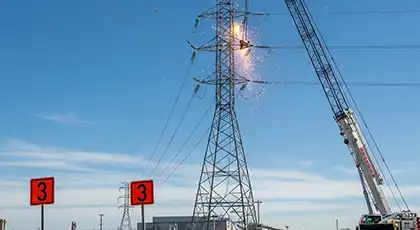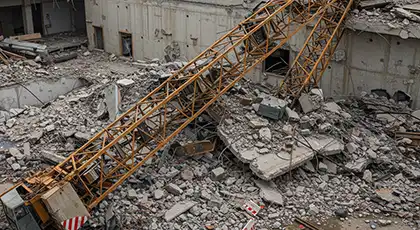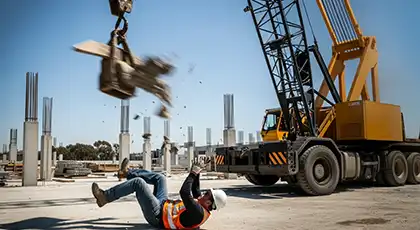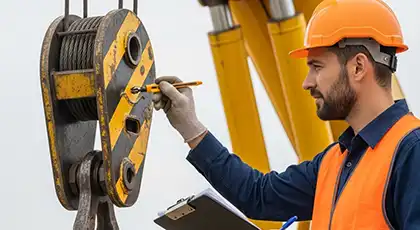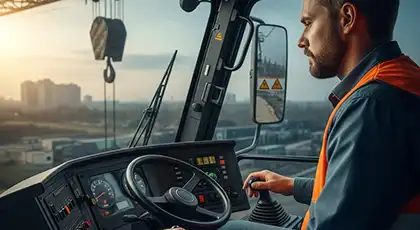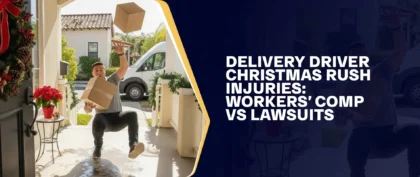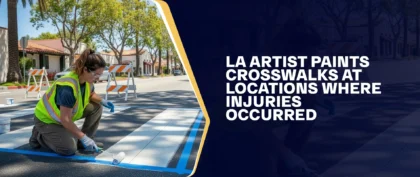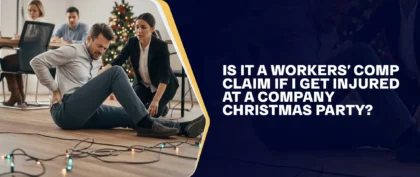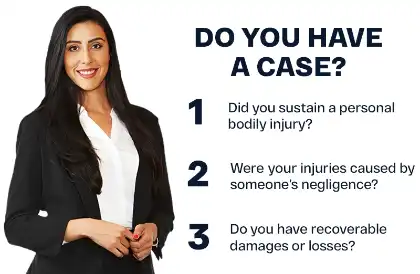TL;DR: The most common types of crane accidents include tip-overs, dropped loads, collapses, contact with power lines, and falls. These incidents often stem from overloading, poor planning, or mechanical failure and can result in severe injury or death.
Table of Contents
Crane accidents can result in serious injuries on construction sites. The most common types include tip-overs, dropped loads, contact with power lines, collapses, struck-by incidents, falls, and transportation-related crashes. These accidents often happen due to overloading, equipment failure, poor setup, or lack of safety planning.
Depending on the circumstances, injured workers may qualify for compensation through workers’ compensation or a personal injury claim. Understanding how crane accidents happen can help establish fault and identify who may be responsible, whether it’s an employer, contractor, or equipment manufacturer.
If you sustained injuries in a crane accident, you may have grounds to seek compensation for your injuries, lost income, and other losses. The crane accident attorneys at Arash Law can help you understand your legal options. Call us at (888) 488-1391 for a free initial consultation.
Common Crane Accidents
Construction sites use different types of cranes depending on the job. Some projects rely on tall tower cranes, while others use mobile or smaller models. These machines are essential for lifting heavy objects high into the air. However, when something goes wrong, the results can be severe.
The Census of Fatal Occupational Injuries (CFOI) recorded 297 crane-related deaths in the United States from 2011 to 2017, averaging 42 deaths per year. More than half of these involved workers were struck by falling objects or machinery.
The private construction industry was involved in 43% of all crane-related deaths during that period, making it the most affected sector. The manufacturing industry followed, accounting for 24% of fatalities. According to the U.S. Bureau of Labor Statistics, below are the five states with the highest crane-related deaths from 2011 to 2017.
- Texas (50)
- Florida (16)
- New York (16)
- California (14)
- Illinois (14)
Understanding the different types of crane accidents can provide valuable information for your claim, helping to determine how your accident occurred, clarify the circumstances, identify potentially responsible parties, and assess whether the incident could have been prevented. Below are the most common crane-related incidents that often result in injury claims.
Tipping Over
Tip-overs are among the most serious types of crane accidents. This incident usually occurs because of overloading, unstable ground, or improper setup. When a crane overturns, it can cause severe damage, serious injuries, or even death.
A crane can tip over due to:
- Improper or unstable setup.
- Lack of counterweights.
- Uneven ground without proper leveling.
- Overloading the crane.
- Strong winds or extreme weather.
- Insufficient operator training or mishandling.
- Mechanical issues due to poor maintenance.
Preventing crane tip-overs requires regular maintenance, proper planning, and careful execution. Operators must follow load charts, inspect equipment on schedule, and set up outriggers according to the manufacturer’s recommendations. Operators must consider weather conditions like wind and rain before every lift. On uneven ground, rough-terrain cranes can provide better stability than standard models.
Crane operators often bear responsibility for tip-over incidents. However, employers and site supervisors may also be held liable, especially if they failed to train staff or hire unqualified workers. If you’re not sure whether you may have grounds to pursue compensation for the injuries suffered in a crane tip-over accident, our injury attorneys can review your case and explain your legal options.
Contact With Power Lines
The results can be deadly when a crane comes into contact with power lines. These accidents often cause catastrophic injuries, fires, explosions, or even electrocution. They may also lead to property damage and power outages. Poor communication, adverse weather conditions, and inadequate training can result in these incidents.
Many incidents happen because crews fail to plan properly or misjudge distances. Poor weather conditions like strong winds, rain, or fog can reduce visibility and create challenging conditions for crane operations.
To reduce the risk of power line contact, crews should:
- Identify all power lines and maintain a safe distance.
- Use high-visibility markers to show wire locations.
- Shut off power lines nearby when possible.
- Use barriers and warning signs around high-voltage areas.
- Prepare for emergencies with clear safety plans.
If a supervisor or employer disregards these safety measures, they may be held liable for any resulting injuries, depending on the specific circumstances. In many cases, injured workers may be eligible to file a workers’ compensation claim. Third-party liability may also apply if another party contributed to the unsafe conditions.
Call (888) 488-1391 to speak with one of our injury lawyers. We can explain your rights and explore your legal options after a crane accident involving power lines.
Falling From The Crane
Falling from a crane can cause severe construction injuries. These incidents often happen when workers install or remove steel beams at height or during the assembly and disassembly of tower cranes. In these situations, unstable platforms, shifting loads, and limited footing increase the risk of falling.
Here are some ways to prevent falls:
- Wearing harnesses, lanyards, and other fall protection gear.
- Using personal protective equipment (PPE) like hard hats, boots, gloves, and safety vests.
- Maintaining three points of contact when entering or exiting the crane cab (two hands and one foot, or two feet and one hand).
The Occupational Safety and Health Administration (OSHA) requires employers to inform workers of fall hazards and provide proper fall protection safety equipment. This includes guardrails, harness systems, and safety nets.
Crane Collapse
A crane collapse can cause catastrophic damage in seconds. These incidents often result from structural failure, overloading, or improper assembly. When a crane falls, it can crush workers, damage property, or harm bystanders nearby.
Common causes of crane collapses include:
- Lifting loads beyond the crane’s capacity.
- Incorrect assembly or misaligned components.
- Structural or mechanical failure.
- Unstable ground or extreme weather.
- Operator mistakes or miscommunication.
Employers must keep cranes safe through regular inspections, proper setup, and routine maintenance. If a crane collapses due to poor oversight, employers may be held liable for any resulting damages. Similarly, contractors or manufacturers may be held liable if defective parts or faulty repairs contributed to the incident, although each case depends on its specific circumstances.
A crane collapse in a construction accident can cause serious injuries to workers and bystanders. If you or someone you know suffered injuries on the job, our personal injury lawyers at Arash Law can help investigate the accident and gather evidence to identify potentially liable parties.
Dropped Load
When a crane accidentally drops its load, the results can be deadly. Heavy objects may fall if the rigging breaks, the load shifts, or the crane isn’t working properly. These accidents often happen without warning and can seriously hurt anyone nearby.
Common causes include:
- Broken or damaged equipment.
- Loads that aren’t secured properly.
- Operator mistakes.
- Lifting too much weight.
- Carrying unbalanced or uneven loads.
To stay safe, crane operators and riggers must be trained and certified. They also need to check the crane and rigging before every use.
Using machines that track weight in real-time can help prevent overloading. Keeping good records of crane maintenance also helps prevent accidents.
OSHA has rules to prevent dropped loads. If a dropped load injures you at work, report the accident and consider consulting a lawyer. Our attorneys can review your case and explain your options to you. Call (888) 488-1391 or complete our “Do I Have A Case?” form here for a free initial consultation.
Struck-By Accidents
Struck-by accidents happen when a moving object hits a person, like a swinging load or falling materials from a crane. These are among the most common causes of fatal crane injuries.
The U.S. Bureau of Labor Statistics reports that struck-by incidents account for many crane-related deaths. Many incidents happen when workers enter the lift zone or when loads aren’t properly secured.
To reduce the risk of being struck:
- Secure all loads before lifting.
- Review tasks and safety rules each day.
- Stay out of marked lift zones.
- Watch for warning signs, alarms, and signals.
- Wear bright, visible clothing.
Contractors, crane operators, and employers all share the duty to keep job sites safe. If a worker or bystander gets struck by a crane, they may have grounds to pursue compensation for the resulting injuries and losses.
Our injury attorneys at Arash Law have years of experience assisting individuals injured in crane accidents in seeking accountability from the at-fault parties.
Transportation-Related Accidents
Crane accidents don’t just happen during lifting. They can also occur while moving or transporting the crane. These motor vehicle crashes may involve other vehicles, nearby buildings, or people on the ground.
Accidents often occur when operators lose control while relocating the crane. Common causes include:
- Poor signaling
- Lack of training
- Operator fatigue or vision problems
- Driving in areas with obstacles or foot traffic
Spotters play a key role in keeping people safe during crane transport. They help guide the operator and warn about hazards on the ground.
To help prevent transport-related accidents:
- Keep in constant contact with the spotter.
- Clear the area of obstacles before moving.
- Only allow qualified operators to drive the crane.
- Keep cranes away from roads, walkways, and public areas.
- Make sure signalers stay out of the crane’s path.
These accidents can harm crane operators, nearby workers, and bystanders. You may be able to file a claim if poor planning, lack of training, or unsafe actions contributed to your injury. After reviewing your case, our lawyers can help assess who may be responsible and explain the legal options available to you.
Safety Guidelines To Prevent Crane Accidents
Crane work can be dangerous, but following safety rules may help prevent accidents. The Occupational Safety and Health Administration has clear rules that employers must follow to protect workers.
Here are key safety steps:
- Check the Ground First — Before using a crane, the controlling entity or whoever has overall authority of the construction site must make sure the ground is strong, level, and stable enough to hold the crane and its load.
- Know Where Power Lines Are — The employer must find all nearby power lines and know how much voltage they carry. They must work with the crane operator and crew to plan the lift, keep a safe distance, and take steps to prevent contact and electrocution.
- Inspect the Crane Often — A trained inspector must check the crane on a regular schedule and after any repairs or changes.
- Hire Trained Workers — All crane operators and signalers must be certified and know how to do the job safely.
- Choose the Right Crane and Setup — A qualified professional needs to approve the crane setup. All parts must follow the manufacturer’s safety rules.
- Secure Every Load — Operators must make sure safety devices work and that the load is properly rigged. They must also check wires for damage before lifting.
If you work near cranes, stay alert. Wear bright clothing, stay out of swing areas, and report any unsafe crane use to a supervisor.
OSHA rules can vary by industry. Most of the rules above apply to construction, but other sectors like shipping, electrical work, and manufacturing also use cranes and must follow similar safety standards.
If a company ignores these rules and someone suffers harm, evidence of their inaction may support a legal claim. Our personal injury attorneys can review your situation and explain how safety violations might impact your legal options.
Injuries Victims May Sustain In Crane Accidents
Crane accidents often cause serious injuries that can have a significant impact on a victim’s life. Because of a crane’s size, weight, and height, these injuries can happen in an instant and may take months or even years to recover from.
- Traumatic Brain Injuries (TBIs) — A strong blow to the head can cause a brain injury. TBIs may result in problems with memory, focus, or movement. These injuries often happen when workers are struck by falling objects or fall from a height.
- Spinal Cord Injuries — Falls or crushing accidents can cause spinal cord damage and result in partial or full paralysis. These injuries often require long-term care and may affect mobility for life.
- Bone Fractures — Crane accidents can cause bones to break or shatter. These injuries may need surgery and months of healing.
- Internal Organ Damage — A heavy impact can damage organs and cause internal bleeding. These injuries are hard to see right away, but can be life-threatening without fast medical help.
- Electrical Injuries — If a crane hits a live power line, the electricity can travel through the crane and into the ground. This can cause electrical burns, heart problems, or nerve damage.
- Amputations — In some cases, crane equipment may crush or trap body parts. Some injuries may require surgical amputation.
- Cuts and Abrasions — Sharp metal edges or falling objects can cause deep cuts. If not treated, these injuries can lead to infections or nerve damage.
If a crane accident causes a worker’s death, the family may be able to pursue a wrongful death claim. This can help cover funeral costs and other losses. Our attorneys for personal injury can review their specific situation and explain the legal options available to them during this difficult time. Fill out our contact form to learn more.
Commonly Asked Questions About Crane Accidents
You may have many questions if you were hurt in a crane accident. Below are some answers to common inquiries about crane accidents. If you still have questions after reading this section, contact our experienced injury lawyers.
What Should I Do If I Was Hurt In A Crane Accident?
If you haven’t already, seek medical treatment and follow your doctor’s instructions. Focus on your recovery and keep records, from hospital bills and prescriptions to test results and follow-up visits.
Even if you’re no longer at the scene, you can still take some precautions that may help protect your rights:
- Report the injury to your employer immediately. Failure to report a workplace injury may result in the claim’s denial.
- Save any photos or videos taken at the time of the accident.
- Write down what you remember about how the accident happened.
- Keep copies of your medical records and discharge papers.
- Hold onto any communication from your employer, insurance company, or witnesses.
Consulting with a personal injury lawyer early in the process may give your attorney ample time to collect evidence and build a case on your behalf.
What Causes Most Crane Accidents On Construction Sites?
A combination of human error, mechanical failure, and environmental hazards typically causes crane accidents. The most common causes include:
- Overloading and Improper Rigging — Lifting loads beyond the crane’s rated capacity or using faulty rigging can result in dropped loads, boom collapse, or tip-overs.
- Unstable Ground Conditions — Cranes require solid, level ground. Soft soil, slopes, or incorrect outrigger deployment increase the risk of overturning.
- Contact with Power Lines — One of the deadliest types of crane accidents, often caused by failure to maintain safe clearance from energized lines. These incidents may result in electrocution, fires, or explosions.
- Operator Error — Inadequately trained or distracted crane operators may misjudge swing radius, load weight, or positioning, resulting in catastrophic outcomes.
- Mechanical Failure and Poor Maintenance — Worn cables, faulty brakes, hydraulic leaks, or broken components cause equipment failure during operation.
According to the Census of Fatal Occupational Injuries (CFOI), crane accidents were responsible for 297 deaths in the U.S. from 2011 to 2017. Over 50% of these involved workers being struck by falling objects or crane equipment. The construction industry accounted for 43% of all fatalities. Texas reported the highest number, with 50 crane-related deaths during that time. Proper site planning, OSHA-compliant safety protocols, certified operators, and scheduled equipment inspections are essential to reduce the risk of crane accidents on construction sites.
What Are My Legal Rights After A Crane Accident In California?
If you suffer an injury on the job, you may be able to file a workers’ compensation claim. This can help seek compensation for medical bills, a portion of your lost wages, and disability benefits. Generally, you do not need to demonstrate that your employer was at fault.
Workers’ comp does not cover everything. It does not compensate for pain and suffering and only offers limited coverage for lost income, even in cases of permanent disability. If someone other than your employer caused the accident, you may also be able to file a personal injury claim in addition to workers’ compensation, depending on the situation. Many workers’ compensation attorneys handle both cases and can explain which path may be appropriate for your situation.
You may still have a case if you were not working and got injured as a bystander. Property owners, contractors, or crane operators may be held responsible if they acted carelessly. Speak with a personal injury attorney to determine an estimate of what your claim may be potentially worth.
Are Crane Accidents Covered By Workers’ Compensation Or Personal Injury Claims?
Most crane accident victims may pursue both workers’ compensation and personal injury claims simultaneously, depending on the circumstances.
Workers’ Compensation (if injured at work):
- Covers all medical expenses and rehabilitation.
- Provides partial wage replacement.
- Includes disability benefits if applicable.
- Available regardless of who caused the accident.
Personal Injury Claims (if a third party caused the accident):
You can sue parties other than your employer, including:
- Crane manufacturers (for defective equipment).
- Maintenance companies (for improper repairs).
- General contractors (for unsafe conditions).
- Other subcontractors (for negligent actions).
Personal injury claims allow injury victims to seek damages not covered by workers’ compensation, such as full lost wages, pain and suffering, emotional distress, and future earning losses.
If you weren’t working at the time of the accident, only personal injury claims may apply, as workers’ compensation doesn’t cover bystanders.
California law permits both claims simultaneously, and many cases involve multiple responsible parties.
For detailed guidance, you can contact us at (888) 488-1391 to schedule a free case review with our workers’ compensation and workplace accident lawyers.
What Is The Deadliest Type Of Crane Accident?
Struck-by accidents are among the serious types of crane incidents, responsible for the majority of crane-related fatalities, according to the U.S. Bureau of Labor Statistics.
These accidents occur when moving crane components, swinging loads, or falling materials strike workers or bystanders on or near the construction site.
Why are crane accidents so fatal?
- Massive Impact Force — Cranes often lift loads weighing thousands of pounds. If one falls, the force is enough to cause instant fatal injuries.
- No Warning Time — Unlike mechanical failures or tip-overs, struck-by incidents happen in a split second.
- Multiple Victims — A single dropped load or swinging boom can hit several people at once.
Common causes and scenarios include:
- Workers entering or working within unsafe lift zones during active crane operation.
- Rigging failure, causing a suspended load to fall without warning.
- Crane booms that are swinging unexpectedly into active work areas.
- Construction materials slipping or dropping from height.
Over 50% of the 297 crane-related deaths recorded between 2011 and 2017 were due to struck-by incidents.
Prevention strategies include:
- Strict enforcement of exclusion zones.
- Use of high-visibility PPE and worksite signage.
- Daily safety briefings before crane operations.
- Reliable signaling and communication between operators and spotters.
If you or a loved one suffered injuries in a crane-related struck-by incident, consider speaking with a legal team that handles construction accident cases. Our construction accident lawyers can help you explore your legal options. You may be able to seek compensation beyond workers’ comp, especially if third-party negligence is involved.
Who Are The Possible Responsible Parties In Crane Accidents?
More than one party may be held responsible. This depends on what caused the accident. Common responsible parties include:
- Construction companies that fail to train workers or follow safety rules.
- Crane operators who make mistakes or break safety procedures.
- Manufacturers of cranes or parts that are faulty or unsafe.
- Maintenance crews that do not fix or inspect equipment properly.
- Supervisors or site managers who ignore known dangers.
- Property owners who allow unsafe conditions on their land.
Your lawyer can investigate the accident, review the evidence, and identify the parties who may be responsible and work to help you pursue accountability for the harm they caused.
What Damages Can Victims Seek From A Crane Accident?
The type of compensation you can pursue depends on your situation. If you were working when the accident happened, you may have a workers’ compensation claim. You may also have a personal injury claim if someone other than your employer caused the accident.
- Workers’ Compensation Claim — Workers’ compensation helps injured employees get medical care and partial wage replacement without needing to prove fault. It typically covers:
- Medical bills related to the injury.
- Ongoing treatment and rehabilitation.
- A portion of lost wages.
- Temporary or permanent disability benefits.
- Workers’ comp does not pay for pain and suffering or emotional distress.
- Personal Injury Claim — A personal injury claim may apply if a third party, like a contractor, equipment manufacturer, or property owner, was responsible for the accident. It’s crucial to show that their carelessness or unsafe actions caused your injury.This type of claim may include:
- Full payment of medical expenses.
- All lost income and reduced earning ability.
- Pain and suffering.
- Emotional distress.
- Loss of enjoyment of life.
- Loss of companionship or support.
- Wrongful Death and Survival Claims — If a loved one died in a crane accident, their family may be able to file a wrongful death claim for funeral costs and the loss of financial and emotional support. The victim’s estate may also file a survival action to seek damages the person could have claimed if they had survived.
Do I Need A Personal Injury Lawyer For My Crane Accident Case?
You don’t have to hire a lawyer, but doing so can be beneficial, especially if your case involves both a personal injury claim and a workers’ compensation claim. These cases can quickly become complex, and a simple misstep could affect the outcome of your case.
An experienced personal injury lawyer can explain your rights as a worker, gather evidence, communicate with insurance companies, and guide you through each stage of the legal process.
At Arash Law, we’re committed to helping many injured workers and their families after serious crane accidents. We understand that every case is unique. Our team will work to develop a legal strategy that aligns with your specific situation and supports your recovery.
Reach Out To Arash Law To Discuss Your Crane Accident Claim
Crane accidents can make a significant impact on an individual’s life. Whether you’re a construction worker hurt on the job or a bystander injured near a crane site, you may have legal options available.
At Arash Law, we help injured people understand their rights and take legal action. Our attorneys will listen to your story, explain your options, and guide you through the legal process while you focus on healing.
We work on a contingency fee basis, which means you don’t pay attorney’s fees unless a settlement or court award is obtained. While certain case-related costs may still apply regardless of the outcome, our fee structure allows you access to legal counsel without upfront costs. Our personal injury lawyers will thoroughly discuss our payment structure and any related expenses with you before proceeding.
Each case is different, and results depend on the specific facts and evidence. Our team employs a client-focused approach when handling your case. We can advocate for your legal rights based on your unique situation.
Looking for free accident lawyer advice? Arash Law offers free initial consultations to clients. If you suffered injuries in a traffic-related crash, our pedestrian, truck, Uber, Lyft, motorcycle, and car accident lawyers can assist you with the legal process. Call us at (888) 488-1391 to discuss your case with an attorney.

